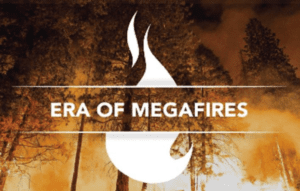Fire Behavior
View webinar recording.
This seminar was presented by Matt Reeves at the Missoula, MT, Rocky Mountain Research Station Fire Lab.
View article.
This study found that cross-validated results generally indicate a higher occurrence of smaller fires when months preceding fire season are wet, while larger fires are more frequent when soils are dry. This is consistent with the concept of increased fuel accumulation under wet conditions in the pre-season. These results demonstrate the fundamental strength of the relationship between soil moisture and fire activity at long lead-times and are indicative of that relationship’s utility for the future development of national-scale predictive capability.
Access story map.
The 2017 Fire Narrative and Timeline tells the story of successes and challenges, and also addresses emerging technology and science, such as Quantitative Risk Assessment, Risk Management Assistance Teams, and using Unmanned Aircraft Systems (drones) for infrared and reconnaissance flights.
View webinar recording.
Large wildfire incidence has increased in forests throughout the western U.S. following changes in vegetation structure and pattern, along with a changing climate. Given this increase there is great interest in whether fuels treatments and previous wildfire can alter fire severity patterns in large wildfires. The 255,000 acre 2013 Rim Fire created an opportunity to study fuels treatment effects across a large forested landscape in the Sierra Nevada. We assessed the relative influence of previous fuels treatments (including wildfire), fire weather, vegetation and water balance on Rim Fire severity. We did this at three different spatial scales to investigate whether the influences on fire severity changed across scales.
Access videos.
The World of Wildland Fire vision is to provide and connect fire science educators, trainers, and the public with scientifically solid and peer-reviewed teaching tools and techniques, using state-of-the-art materials, which will be free and accessible to all. This is done to significantly enhance the learning experience.
Visit Interagency Fuels Treatment Decision Support System (IFTDSS) website.
IFTDSS is a web-based software and data integration framework that organizes previously existing and newly developed fire and fuels software applications to make fuels treatment planning and analysis more efficient and effective. You must create an account to begin using this tool.
View report.
Much of the Murphy Wildland Fire Complex burned under extreme fuel and weather conditions that likely overshadowed livestock grazing as a factor influencing fire extent and fuel consumption in many areas where these fires burned. Differences and abrupt contrast lines in the level of fuels consumed were affected mostly by the plant communities that existed on a site before fire. A few abrupt contrasts in burn severity coincided with apparent differences in grazing patterns of livestock, observed as fence-line contrasts. Fire modeling revealed that grazing in grassland vegetation can reduce surface rate of spread and fire-line intensity to a greater extent than in shrubland types. Under extreme fire conditions (low fuel moisture, high temperatures, and gusty winds), grazing applied at moderate utilization levels has limited or negligible effects on fire behavior. However, when weather and fuel-moisture conditions are less extreme, grazing may reduce the rate of spread and intensity of fires allowing for patchy burns with low levels of fuel consumption.
View report.
Targeted livestock grazing must be carefully implemented and monitored to meet fuels management objectives on an annual and long-term basis. Grazing to reduce fuels on a landscape must be both strategic and surgical. Surgical means that targeted livestock grazing will be done to the level and limited to the minimum area needed to meet fuel and landscape or project management objectives within BLM’s regulatory framework. Therefore, sound project planning is essential.
View the Ted Talk.
The Era of Megafires is a 70-minute, multi-media presentation hosted by Dr. Paul Hessburg, who has conducted fire and landscape ecology research for more than 27 years. The presented material comes in the form of fast-moving, short, topic-based talks interspersed with compelling video vignettes and features the work of wildfire photographer, John Marshall. Think Ted X mixed with snappy documentary shorts and compelling photography. The videos are produced by award-winning documentary film company, North 40 Productions, of Wenatchee, WA.
The presentation is designed to educate audiences across the West so that they may better participate in the conversation and solutions surrounding the Megafire issue.
Sponsors for this event include U.S. Forest Service Intermountain Region, Salmon-Challis National Forest and the Northern Rockies Fire Science Network.
The presentation will take place at the Sacajawea Center in Salmon, Idaho. Doors will open at 6:30PM, and the presentation will begin at 7:00PM.
The LANDFIRE Program strives to produce consistent fire behavior fuel model grids for the U.S. These models are relevant for predicting fire behavior, including spread and intensity, during average conditions; however, they often fall short during drought or seasonably dry conditions.
To address the need for that information, LANDFIRE developed a seasonal product named the Modeling Dynamic-Fuels with an Index System (MoD-FIS). These provisional products have been released for the Southwest and Great Basin regions, and are ready for testing and review by those who use LANDFIRE data. In this webinar, Charley Martin and Tobin Smail offer a MoD-FIS primer, explain how the products can be used in these regions, and solicit users’ input and review.
This webinar was co-hosted by LANDFIRE and members of the Joint Fire Science Program: Great Basin Fire Science, Southwest Fire Science, and Northern Rockies Fire Science. Content addresses challenges that managers of large landscapes deal with in these regions.


